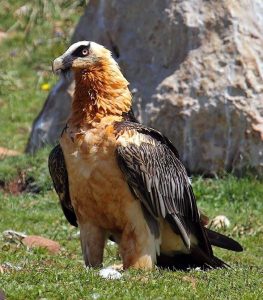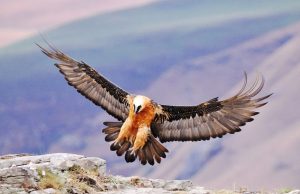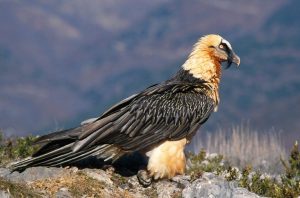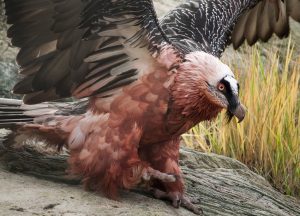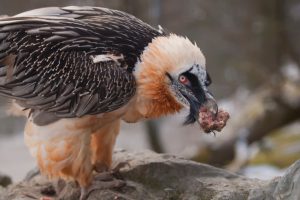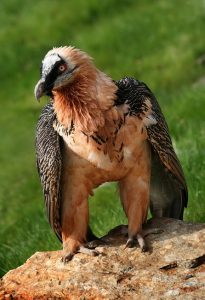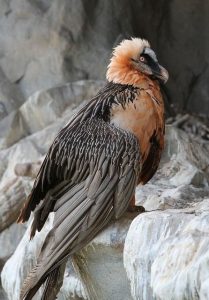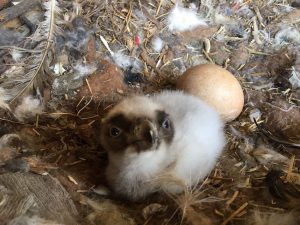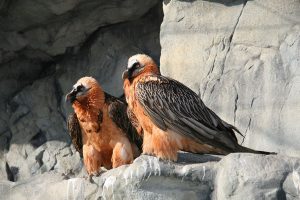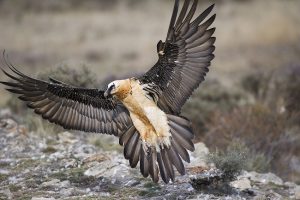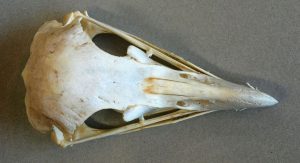Bearded Vulture
Imagine a bird so fierce, it can crack bones with nothing more than its powerful beak. The Bearded Vulture is a living testament to the relentless drive of nature’s most efficient scavenger. Its razor-sharp talons and specialized diet—feasting on bones, not just meat—make it one of the most intriguing and formidable creatures on the planet. This bird doesn’t just survive; it reigns over the wild landscape, mastering an art of survival few other species can even dream of.
In the rugged cliffs of Europe, Asia, and Africa, a bird soars above the landscape with unmatched precision. The Bearded Vulture isn’t your average scavenger. Its hunting style is as unique as its appearance, with a bone-crushing beak capable of breaking open carcasses to feast on the marrow that lies within. Yet, it’s not just its remarkable feeding habits that set it apart. The Bearded Vulture’s mating rituals are just as extraordinary, as these solitary creatures forge lifelong bonds through an intricate courtship of aerial displays and shared territories. But beneath its awe-inspiring behaviors lies a deep vulnerability—this magnificent bird is listed as Near Threatened, with populations dwindling due to habitat loss and human activity. The Bearded Vulture’s survival is in our hands, and understanding its behavior is the key to ensuring it soars through the skies for generations to come.
Unique Feeding Behavior of Bearded Vultures:
Also known as the Lammergeier, it’s one of the most distinctive vultures due to its unique feeding behavior, particularly its bone-crushing diet. Unlike many other vultures that feed on soft tissue, the Bearded Vulture primarily consumes bones, including large mammal bones, which are cracked open to access the marrow inside.
1. Bone-Crushing Adaptations:
The Bearded Vulture has specialized physical features that allow it to feed on bones. Its powerful beak is designed for breaking bones, and it is often referred to as the “bone breaker.” The vulture is capable of carrying bones in its talons and dropping them from great heights onto rocks, breaking them open. This behavior, known as “bone-dropping,” is a critical adaptation that enables the bird to access the rich nutritional marrow inside large, hard-to-digest bones.
2. Marrow Consumption:
After the bones are broken into smaller pieces, the Bearded Vulture feeds on the nutrient-rich marrow. The bird’s digestive system is adapted to process these tough, mineral-rich bones, which provide an essential part of its diet. The vulture can consume bones from small mammals to large ungulates, and its diet often includes bones that other scavengers cannot access.
3. Foraging Behavior:
Bearded Vultures are often seen flying in search of bone-rich carcasses or carcasses left by hunters. They can travel long distances over mountains and across valleys in search of bones to feed on. Their impressive wingspan (up to 2.8 meters) aids in soaring high above the landscape, allowing them to spot potential food sources from great distances.
Scientific Classification
| Kingdom | Animalia |
| Phylum | Chordata |
| Class | Aves |
| Order | Accipitriformes |
| Family | Accipitridae |
| Genus | Gypaetus |
| Scientific Name | Gypaetus barbatus |
Unique Mating Behaviors of Bearded Vultures:
Bearded Vultures exhibit fascinating mating behaviors that revolve around their monogamous nature. They are known to form long-lasting pair bonds that can last for life.
1. Courtship and Nesting:
During courtship, Bearded Vultures engage in aerial displays, where they perform impressive flying maneuvers to attract a mate. The males often present bones to females during courtship, offering them as a sign of strength and the ability to secure food. These bone gifts help the male demonstrate his fitness as a mate.
2. Nesting:
Bearded Vultures typically nest in cliffs or high, remote mountainous regions. Their nests are often built on ledges or in large caves, providing safety from predators. Both males and females contribute to the nest-building process, using sticks, feathers, and bones to construct a sturdy nest. They often reuse their nests over multiple breeding seasons.
3. Parenting:
After mating, the female lays one or two eggs, which both parents incubate for around two months. The parents are highly attentive, ensuring that the eggs are kept warm and safe. After hatching, the parents continue to care for their chick, feeding it bones from their own meals. This long-term parental investment helps ensure the survival of the young bird.
Quick Information
| Also known as | Lämmergeier, ossifrage |
| Description | Size: 37-49 inches (94-125 centimeters) Weight: 9.9-17.2 lbs (4.5-7.8 kg) Wingspan: 7.6-9.3 ft (2.31-2.83 m) Color: Adults are whitish, dark grey and rust colored; dark grayish-black or grayish-blue on the dorsal side with a darker tail but with lighter shafts; the forehead is cream-colored; there is a black-band around the eyes; there is black hair under the chin that gives them their name; plumage on the head, breast and leg varies between orange and rust Sexual Dimorphism: Females marginally larger |
| Distribution | Mountains of Europe and Asia, including the Pyrenees, Alps, Caucasus, Zagros Mountains, Alborzs, Afghanistan, Altai Mountains, the Himalayas, as well as in the Arabian Peninsula; Also scattered sporadically throughout Africa, south all the way to South Africa |
| Habitat | Meadows, alpine pastures, heaths, montane savannas, rocky valleys, steppes, and forests |
| Sounds & Calls | Mostly silent; makes a ’cheek-acheek’ call around the nest and high-pitched whistles during breeding displays |
| Lifespan | Wild: More than 21 yearsCaptivity: At least 45 years |
| Diet | Being a scavenger, it feeds on carrion, specifically bones and bone marrow of dead animals, which makes up as much as 90% of its diet; live animals, especially tortoises, are also taken |
| Adaptations |
|
| Predators | Golden eagles, griffon vultures, and common ravens prey on chicks; adults may also have hostile relationships with these birds, although they are not preyed upon |
| IUCN Conservation Status | Near Threatened |
Conservation Status of Bearded Vultures:
The Bearded Vulture is classified as Near Threatened by the International Union for Conservation of Nature (IUCN), due to a range of factors that have impacted its populations.
1. Habitat Loss and Fragmentation:
The Bearded Vulture’s natural habitat consists of high-altitude mountainous areas, often in remote locations. These areas are increasingly being impacted by human activities such as land development, tourism, and infrastructure projects. The fragmentation of suitable nesting sites has made it more difficult for these birds to find undisturbed areas to breed.
2. Poisoning and Hunting:
Poisoning, both accidental and intentional, has been a significant threat to the Bearded Vulture. They are sometimes poisoned by ingesting carcasses contaminated with lead or pesticides. Additionally, the species has historically been persecuted by humans, who viewed it as a threat to livestock, although this perception has lessened in recent years.
3. Food Scarcity:
As scavengers that depend on bones, the Bearded Vulture is vulnerable to changes in the availability of carcasses. The decline in large herbivore populations, either due to overhunting or climate change, can reduce the availability of food for vultures, negatively impacting their ability to thrive.
4. Conservation Efforts:
Despite these challenges, conservation efforts are underway to protect the Bearded Vulture. These efforts include establishing protected areas in their natural habitats, providing supplemental feeding in areas where food is scarce, and breeding programs in captivity to increase their numbers. Additionally, awareness campaigns have helped to reduce human persecution and promote the importance of vultures in ecosystems as natural cleansers.
Behavior
- Bearded vultures do not go in to feed while other scavengers are on a carcass. Instead, they wait patiently for the others to finish eating and go in last to feed on the bones.
- They are diurnal, being active during the day.
- They are usually solitary, other than breeding pairs.
- Pairs partake in attractive flight displays during the breeding season, showing talons, spiraling and tumbling during flight.
Mating & Reproduction
They are monogamous with varying breeding seasons depending on the range. Clutches consist of 1-2 eggs, and rarely 3. They are incubated for 53-60 days.
Life-cycle
The hatchlings fledge 100-130 days after hatching. They are usually dependant on their parents for up to two years. Males reach sexual maturity after 9 years of age while females take around 7 years 8 months.
Summary
The Bearded Vulture is a creature of striking contrasts—an apex scavenger with the ability to break open bones and consume the marrow within, making it a living paradox of power and precision. Its feeding habits are nothing short of extraordinary, showcasing a bird that defies nature’s expectations by thriving on what others discard. But it’s not just about survival; the Bearded Vulture’s mating rituals are equally unique, with these solitary yet deeply bonded birds engaging in spectacular courtship displays that reflect their lifelong commitment to one another. Despite its impressive adaptations, the Bearded Vulture faces increasing threats from human activity and habitat loss, leading to its Near Threatened status. With its dwindling numbers, understanding and protecting this remarkable bird has never been more crucial. The Bearded Vulture represents the beauty of nature’s design—but also the fragility of life in an ever-changing world.
Interesting Facts
- Lammergeier in German means ‘lamb-vulture’.
- In 1625, the Mughal Emperor Jahangir ordered the crop of a bearded vulture checked to confirm that it does indeed, feed almost exclusively on bones.
- There are an estimated 10,000 pairs of wild bearded vultures in the world.
- It is a close relative of the Egyptian vulture.
References:
Published on June 27th 2018 by Mark Matzeldelaflor under Coniferous Forest Animals.
Article was last reviewed on 5th December 2024.


